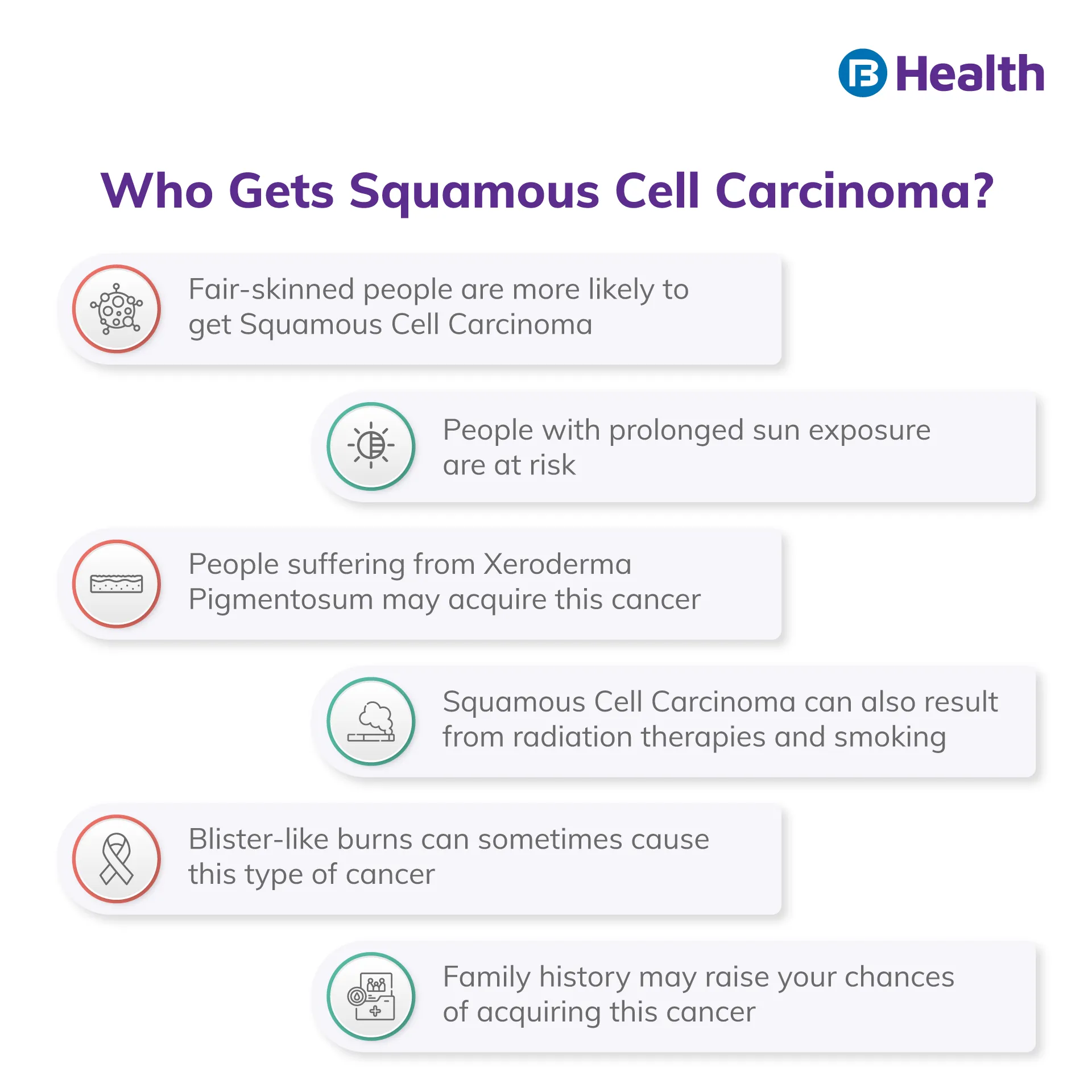Cancer | 8 min read
Squamous Cell Carcinoma: All You Need to Know About This Skin Cancer
Medically reviewed by
Table of Content
Synopsis
Key Takeaways
- Skin is the organ that protects us against germs and controls body temperature
- Squamous cells are present throughout the body, including the lungs, throat, and the top layer of the skin
- The squamous cell acts as a shield to tissues that lie beneath
It is the second most known form of skin cancer found in the body areas which usually get exposed to sunlight, such as arms, legs and head. It is also visible in the body where you have mucous membranes like the mouth, lungs and anus. It is categorized into various types based on the affected organ. Squamous cell carcinoma skin cancer is also called cutaneous squamous cell carcinoma(cSCC). Your body gives early signs of developing a health condition. Hence, discovery in the preliminary stages helps to cure the disease earlier. Keep reading to know more about this cancer, its causes and treatment.
What is Squamous Cell Carcinoma?
Squamous cell carcinoma is the second most common cancer type after basal cell carcinoma. The squamous cell cancer in your skin's top layer of the epidermis is called cutaneous squamous cell carcinoma(cSCC). People diagnosed with this type of cancer can witness red patches and open sores on their skin. It is not usually life-threatening, although if it remains untreated, it may grow and affect deeply. Cancer growing deep may injure blood vessels, nerves and anything on its path. There is also the risk of cancer spreading to other parts of your body and causing severe damage to your health.
Squamous cell carcinoma may grow in any part. However, a higher risk exists in the body part exposed to Ultraviolet radiation caused by sunlight or tanning beds or lamps. You may notice it in areas like the face, neck, hand, arm, legs, ear, and lips, with fewer chances of appearing in mucous membranes and genitals. You may also witness deep wrinkles and discoloured skin before the skin cancer develops. Hence, it is essential to keep checking on your skin changes. People with a higher risk of squamous cell carcinoma tend to have fair-coloured skin and grey, blue, or green hair. There are more chances of development in men compared to women.

Causes of Squamous Cell Carcinoma
The most common cause of squamous cell carcinomais UV exposure from sunlight or indoor tanning from beds and lamps. Here you can find some more squamous cell carcinoma causes.Mutation to the p53 gene
The mutation to the p53 gene is one of the leading squamous cell carcinoma causes. It is the p53 gene that instructs cells to divide and replicate when they reach their lifespan. When the p53 gene is not in the position to give orders properly, cells generate excessively, leading to a tumour that can be cancerous. The mutation to the p53 gene is a situation where the cells don't receive directions properly, which results in duplication of the squamous cell leading to the formation of a tumour in the body. The mutation to the gene occurs mainly due to exposure to sun or indoor tanning.
Smoking
People who smoke frequently have a higher risk of developing squamous cell cancer on their lips. It is also a prime reason for developing lung squamous cell carcinoma.Radiation
It is also possible to develop squamous cell carcinoma due to radiation therapy in the parts for which you received treatment.
Chemical exposure
Risk of developing cutaneous squamous cell carcinoma due to certain chemical substances such as petroleum products, arsenic, and cool bar.
Burn scars
The scars may develop in areas that are severely burned or due to ulcers that have existed in your body for several years.
Genetics
The family history of cutaneous squamous cell carcinoma (cSCC) also contributes to the risk factor.
Additional Read: Colorectal Cancer CausesEarly Signs of Squamous Cell Carcinoma
You can witness a bump or mark on the skin that may give you an indication of developing squamous cell carcinoma.- Actinic keratosis: Formation of a lump that may feel itchy, dry, or looks different from your skin colour
- Leukoplakia: Appearance of white spots in mouth, tongue, or cheeks
- Cheilitis: Formation of lesion on your lower lips where the tissues become dry, pale and cracked
If you notice this skin damage, visit the doctor immediately.

Squamous Cell Carcinoma Symptoms
Few squamous cell carcinoma symptoms to diagnose the condition earlier
- A sore or wound that may not heal
- A sore that may heal first and then return frequently
- Reddish patch, the difference in the colour of the affected skin
- A brown spot that looks similar to an age spot
- A bump or growth which may crust over and bleed
- A horn-shaped, wart-like, or dome-shaped growth
- Raised growth
Squamous cell carcinoma symptoms in the mouth are as follows
- A growth inside the mouth
- Reddish and white patches
- Pain while swallowing
- Sore in mouth or lip that may not heal
Cutaneous squamous cell carcinoma usually appears in red or pink. It can also be:
- White
- Yellowish
- Brown
- Black
Treatment For Squamous Cell Carcinoma
Squamous cell carcinomagrows slowly. Although, it is best to consult the doctor as soon as possible for faster recovery. Here are a few treatments that a cancer specialist usually suggests.
Surgical excision
This is a simple treatment for squamous cell carcinoma. The doctor at first numbs the cancer cells and the area around them with a local anaesthetic. During the surgery, using a scalpel, the doctor removes the cancer cell and some surrounding skin to eliminate cancer from the body. Next, the wound is stitched with the plastic surgery method. Later the sample is sent to the laboratory to ensure the cancerous area has been removed completely. The cure rate with this treatment is typically about 90 to 93%.
Mohs surgery
It is the most trusted treatment for curing squamous cell carcinoma. It is usually suggested when cancer develops on the face, spots larger than one centimetre appear, or when one cannot examine the exact margins of cancer. Then, using a scalpel, the doctor removes the cancer layer by layer and examines it immediately under the microscope. The process is repeated until the cancer cell is completely removed.
Cryosurgery
Liquid nitrogen is used to freeze cancer cells for the purpose of destroying them to treat squamous cell carcinoma. This procedure is repeated multiple times until no cancer cells are found.
Photodynamic therapy
A photosensitizing substance is applied to squamous cell carcinoma in theaffected areas. After one to three hours, the area is exposed to strong light for a few minutes. With this process, the medication gets activated and kills cancer cells.
Systemic chemotherapy
Drugs such as pembrolizumab (Keytruda) and Cemiplimab-Rwlc (Libtayo) are used to treat cancer cells.
The squamous cell carcinoma treatment depends on the factors such as age, severity and location of cancer, and your health condition. [1]
Additional Read: Types of Cancer
Diagnosis of Squamous Cell Carcinoma
The doctor may first ask you about your squamous cell carcinoma symptoms and medical history. Then, a physical examination is conducted on the affected area, and if the doctor suspects cancer, a biopsy is done to confirm the presence of squamous cell carcinoma.In a biopsy, a small portion of the affected skin is taken as a sample for testing. The size of the portion may differ; talk with your doctor about biopsy concerns. Do not miss your follow-ups after treatment. Regular check is essential to eliminate further complications. In most cases, people recover within two to four weeks. However, it may vary for each person. The size and location also affect the healing time.
Complications For Squamous Cell Carcinoma
After Surgery
The complication after squamous cell carcinoma surgery includes scars. The scars may leave behind depending upon the factors such as size, aggressive or non-aggressive and the affected area. Do not take too much stress about scars. It will mature eventually and look better. Some aggressive skin cancer may require radiation on the tumour site, leading to tighter skin or changes in the skin texture.
Risk factors of having cutaneous squamous cell carcinoma
- Having fair skin or light-coloured hair like grey, blue, or green
- Exposure to UV radiation for long term
- Living in sunny locations
- People with health conditions like AIDS and HIV have a higher risk of developing a severe form of squamous cell carcinoma[2]
Types of Squamous Cell Carcinoma
Squamous cell carcinoma is classified into two types depending on the affected area and size:
Cutaneous
As already discussed, cutaneous is a type of squamous cell skin cancer that affects the top layer of the skin or spreads beyond the outer layer of the skin.
Metastatic
Cancer spreads to other parts of your body other than the skin.
The word cancer may sound overwhelming. Although, the one thing which you need to understand is it is treatable. Early detection of squamous cell carcinoma increases the recovery rate. Hence, awareness of cancer helps you to pay attention to developing squamous cell carcinoma symptoms. Suppose you are going through any cancer concern, like uterine cancer, or nasopharyngeal cancer, you can seek guidance through Bajaj Finserv Health App at your convenience. For getting an oncologist’s consultation, you can make an online appointment by registering your details. So, say hi to treatment and lead a healthy life! If you want to protect yourself from skin cancer you can avail cancer insurance
References
- https://www.yalemedicine.org/conditions/squamous-cell-carcinoma
- https://www.everydayhealth.com/skin-cancer/complications/
Disclaimer
Please note that this article is solely meant for informational purposes and Bajaj Finserv Health Limited (“BFHL”) does not shoulder any responsibility of the views/advice/information expressed/given by the writer/reviewer/originator. This article should not be considered as a substitute for any medical advice, diagnosis or treatment. Always consult with your trusted physician/qualified healthcare professional to evaluate your medical condition. The above article has been reviewed by a qualified doctor and BFHL is not responsible for any damages for any information or services provided by any third party.





